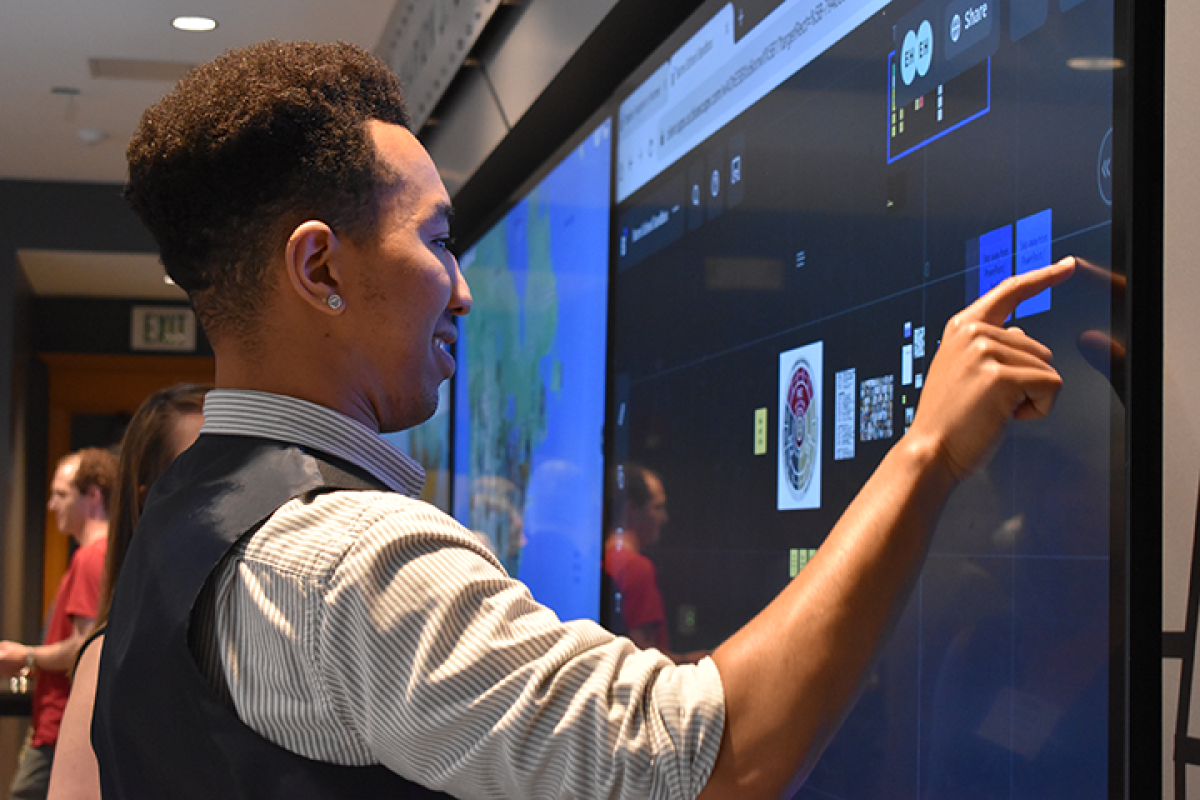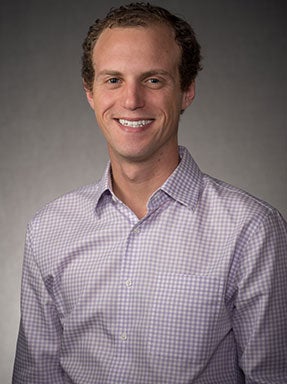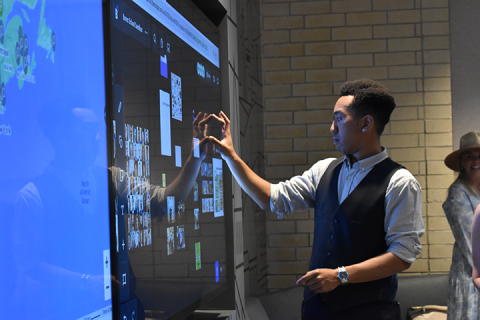New, High-Tech Collaboratory Positions Students for Success
New space invites students, faculty, staff and the community to innovate together

Master’s student Adrian Frank touches the interactive Bluescape wall at the Collaboratory. Photo by Janeena Johnson.
“This is what cyberstalking a property looks like,” Eric Holt says, and his fingers go to work.
With a few strokes of the keyboard and clicks of a mouse, we’re in downtown Miami Beach, Florida, 1,723 miles from the University of Denver campus. The Google Earth satellite view is pristine and comes to life on 7-panel monitors.
Holt’s fingers keep flitting and suddenly, anything seems attainable. He overlays demographic information, nearby amenities, traffic patterns, real-time real estate listings and even popular lunch spots nearby.
“You can get a lot of geospatial data around the property and start determining who the product is, why people would live there, what they want, what their needs are,” explained Holt, an assistant professor in the Franklin L. Burns School of Real Estate and Construction Management. “It’s going to really transform how I teach.”
“Transformative” is a word that gets thrown around a lot when describing the new, Marion J. Crean Collaboratory, located on the third floor of the Daniels College of Business. The arc of LCD screens (known as the Liquid Galaxy) wallpapers an elevated stage. Steps away, an 18-foot spread of interactive touchscreens (the Bluescape wall) allow teams to ideate together, whether they’re in person or online. A conference room comfortably seats at least a dozen for video calls and face-to-face meetings. And in the middle of it all, round tables and rolling chairs equip guests to huddle together and soak up the 360-degree experience.
“Space matters,” said Barbara Jackson, director of the Burns School and visionary behind the Collaboratory. “It influences how we interact, how we connect, how we’re able to solve problems. This is a manifestation of exactly what that means.”
For Jackson, last week’s grand opening was more than a decade in the making. The idea came to her when she taught at Cal Poly, but it wasn’t until she arrived at DU in 2013 that she felt she was on fertile ground to grow it. Daniels was the only institution in the country with a real estate and construction management program within it.
“I saw the vision to create the Burns School as the hub for the most advanced education in real estate and construction, and I feel like we’ve set it up on that trajectory,” Jackson said. “Now we have a platform for seamless interaction between industry and academia. The students will have access like they’ve never had access before to working on real challenges in the real world.”
Real-world challenges are what sprung the Collaboratory in the first place. After weathering 2008’s Great Recession, Nello Gonfiantini III (BSBA 1976, MBA 1977), initiated an endowed professorship in honor of beloved former faculty member Michael Crean. Jackson remembers meeting Gonfiantini at his home in Reno, Nevada, to discuss it.
“And he said, ‘What I would have given to have access to the wisdom of the industry when I was a young man,’” Jackson recalled. The next step was clear. “We needed to find a way to connect the wisdom of the industry with the energy, enthusiasm and passion of the young people today — the next generation of real estate leadership, the next generation of professionals in this business.”
Over lunch, Jackson and Gionfiantini sketched out an initial idea, repurposing the funds into what would become the Collaboratory. Then, they brought the idea to Crean, who agreed, on one condition. The space was to be named for his mother, Marion.
“She was just a wonderful, wonderful woman,” Crean said at the Collaboratory’s grand opening reception last week, where he shared stories of her grit, wit, determination and accomplishment. He gestured toward the south wall. “When I see her name, every time I look up there, I get teary eyed.”
The Burns School cut the ribbon on the Collaboratory with a reception, welcoming students, staff, faculty, alumni and community partners for cake and a glass of champagne. It was a way to celebrate success but also honor the many people whose donations — large and small — raised the $900,000 necessary for construction. Jackson took time to thank everyone who had a hand in the Collaboratory’s creation, including fundraisers, architects, members of the construction team and administrative staff.
Gonfiantini, the man whose donation started it all, was among those soaking in the pristine new facility.
“It’s been a long time coming and I think it will have an amazing effect for the students and people who want to collaborate,” he said. “It’s so applicable to today — the technology and the way people learn.”
Students and faculty showed off the Collaboratory’s capabilities, billing it as part classroom, part innovation space and part learning laboratory. They touted the advisor network conference room, allowing students to connect with alumni and working professionals across the globe, whenever their schedule permits.
“It is the essence of what makes the center so special,” said David Waterman a 2022 graduate whose family helped fund the construction. “It is a place where students and professionals can come together, share ideas and grow both personally and professionally.”
Holt sees it as a way to blend industry knowledge with fresh ideas. For Jackson, it’s an opportunity to engage other departments on campus and perhaps inspire them to create similar spaces of their own. And for Vivek Choudhury, dean of the Daniels College of Business, it’s nothing short of revolutionary.
“One of the things we’ve been talking about since I came here is how digital technology is going to transform the world,” he said. “Real estate is no exception, but we are prepared. Our students will walk out of here with state-of-the-art knowledge about how technology in real estate development and construction management will play in the field.
“This is going to be a game changer. This is going to take our real estate program to the next level.”









